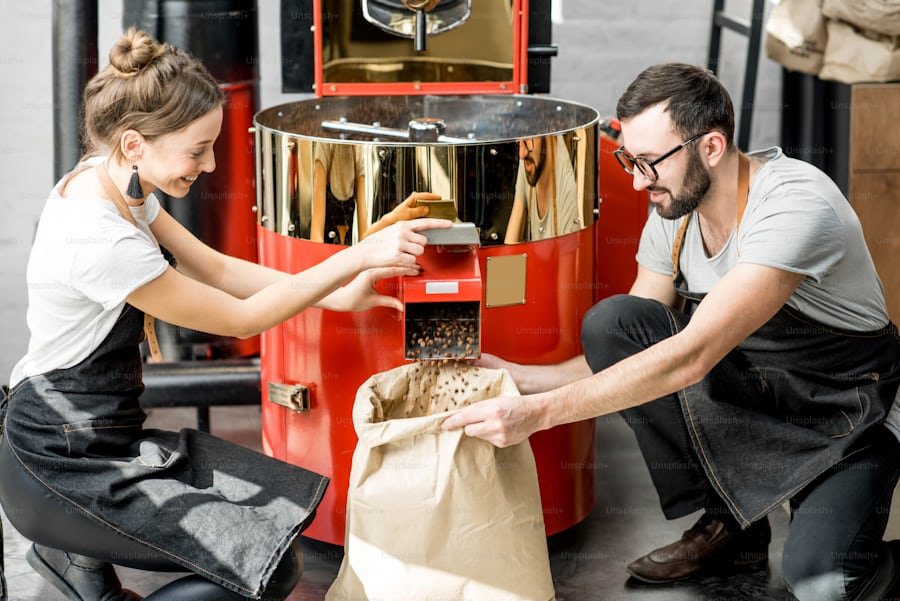Coffee is more than just a beverage; it is a ritual, a comfort, and, for many, an essential start to the day. But have you ever wondered about your coffee’s journey before it reaches your cup? Look closer inside a coffee roastery and uncover the magic behind crafting the perfect brew.
Understanding the Coffee Roasting Process
The art of coffee roasting is a delicate balance of science and creativity. Every bean has its story, and the roasting process brings out unique flavours, aromas, and textures.
Roasting starts with dense green coffee beans with little to no flavour. Through careful application of heat and time, these beans are transformed into the aromatic brown beans we recognize. The process requires precision, as even a slight variation in temperature or duration can significantly alter the flavour profile.
A roaster’s role is not just technical but also profoundly intuitive. They analyze the beans’ origin, altitude, and processing method to determine the perfect roasting style. Light roasts highlight the bean’s natural acidity and fruity notes, while darker roasts emphasize rich, bold flavours. Medium roasts often strike a balance between the two, offering a versatile and approachable cup.
Inside the Coffee Roastery: A Symphony of Senses
Walking into a coffee roastery is an experience like no other. The air is filled with the intoxicating aroma of freshly roasted beans, and the sounds of whirring machines blend with the crackle of beans expanding under heat.
One iconic place that captures this magic is the Grandmother Coffee Roastery. It’s not just a roastery but a place where tradition and innovation meet. The name evokes warmth, nostalgia, and a commitment to excellence that mirrors the careful craftsmanship of a skilled artisan.
At a coffee roastery, every process stage is a sensory adventure. The visual transformation of green beans into rich shades of brown, the fragrant clouds of escaping steam, and the satisfying tactile crunch of freshly roasted beans all contribute to the roaster’s understanding of their craft.
Selecting the Right Beans
Great coffee starts with exceptional beans. Roasters source their coffee from farms worldwide, each with its terroir—a term encompassing the environmental factors affecting the beans’ flavour. From Ethiopia’s volcanic soils to Colombia’s lush highlands, these origins shape the final product.
Ethical sourcing is also a key component of the modern coffee roastery. Many roasteries prioritize direct trade relationships, ensuring farmers are fairly compensated for their hard work. This commitment to sustainability benefits the farmers and guarantees a higher-quality bean.
The Science Behind the Roast
Temperature and time are the twin pillars of the roasting process. A typical roast involves three stages: drying, browning, and development. During drying, the beans shed their moisture content. Browning triggers the Maillard reaction, a chemical process responsible for coffee’s complex flavours and aromas. Development, the final stage, is where the magic happens as the beans reach their optimal flavour profile.
Roasters often rely on state-of-the-art equipment to monitor every aspect of the roast. Computers track temperature curves and airflow, but the roaster’s experienced palate makes the ultimate call. Cupping sessions tasting brewed coffee help fine-tune the roast to perfection.
Beyond the Roast: Blending and Brewing
Once roasted, the beans are packaged as single-origin offerings or blended to create unique flavour profiles. Blending is an art requiring a deep understanding of how different beans interact. The goal is to create a harmonious cup that elevates each component.
Brewing is the final step in the journey from bean to cup. While roasters focus on crafting the perfect roast, they also share their expertise to help customers brew at home. Whether it’s a pour-over, espresso, or French press, each method brings out different aspects of the coffee’s personality.
Celebrating the Coffee Community
Coffee roasteries like Grandmother Coffee Roastery are more than just production spaces; they’re hubs of connection and learning. Many roasteries host workshops, tastings, and community events, inviting coffee enthusiasts to deepen their appreciation for the craft.
These spaces are also a testament to the coffee industry’s collaborative nature. Farmers, importers, roasters, baristas, and consumers all play a role in the journey of coffee. Each cup represents the combined efforts of countless individuals working together to create something extraordinary.
Embracing the Art of Coffee
The next time you sip your morning brew, take a moment to reflect on the journey it’s travelled. From the lush coffee farms to the skilled hands of a roaster, each step adds a layer of care and intention. Coffee is more than a drink; it’s a story, an experience, and an art form.
So why not explore your local coffee roastery or try your hand at home brewing? You might discover a newfound appreciation for crafting perfect coffee.











